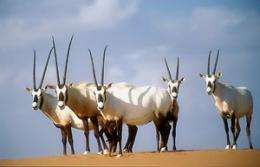A grain of hope in the desert: Arabian oryx leaps back from near-extinction

(PhysOrg.com) -- The regal Arabian Oryx (Oryx leucoryx), which was hunted to near extinction, is now facing a more secure future according to the latest update of the IUCN Red List of Threatened Species. Its wild population now stands at 1,000 individuals.
"To have brought the Arabian Oryx back from the brink of extinction is a major feat and a true conservation success story, one which we hope will be repeated many times over for other threatened species," says Ms. Razan Khalifa Al Mubarak, Director General of the Environment Agency-Abu Dhabi. "It is a classic example of how data from the IUCN Red List can feed into on-the-ground conservation action to deliver tangible and successful results."
The Arabian Oryx, a species of antelope found only on the Arabian Peninsula, is locally known as Al Maha. It is believed the last wild individual was shot in 1972. This year, thanks to successful captive breeding and re-introduction efforts, the oryx has finally qualified for a move from the Endangered category to Vulnerable on the IUCN Red List — the first time that a species that was once Extinct in the Wild has improved by three categories.
Although we are achieving successes, there are some alarming new findings. Of the 19 species of amphibian (frogs, toads and salamanders) that have been added to the IUCN Red List this year, eight are listed as Critically Endangered, including Atelopus patazensis, a species of harlequin toad from Peru, and Dendrotriton chujorum, a dwarf species of salamander from Guatemala. Amphibians remain one of the most threatened species groups with an estimated 41 percent at risk of extinction; the main threats they face include habitat loss, pollution, disease and invasive species.
In the case of New Caledonia's endemic reptiles, which have been assessed for the first time, two thirds (67 percent) of species within this group for which we have sufficient data are at risk of extinction. Many of these reptiles are threatened by ongoing habitat loss and fragmentation as New Caledonia's nickel mining industry continues to expand. This is compounded by the effects of introduced species; for example, deer and pigs damage remaining available habitat, and fire ants, which are invasive alien species, decimate lizard populations, leading to localized extinctions.
"The beautiful South Pacific islands of New Caledonia are home to astonishingly high biodiversity, including a remarkably high number of reptiles found nowhere else on earth. The recent Red List assessments place a spotlight on how many of these unique animals may face extinction, and serves as a call to action. With this new information, governments, NGOs and other stakeholders will be better able to identify priority species and sites for conservation, and more effectively address the threats to these remarkable animals," said Conservation International's Naamal De Silva, Senior Advisor for Conservation Priorities in Asia-Pacific, who facilitated the Red List Assessment workshop for reptiles and has been involved with CI's work in New Caledonia since 2004.
A further new addition to the IUCN Red List is the recently discovered primate Wallace's Tarsier (Tarsius wallacei). This forest-dwelling species was first described in 2010, and is found in just two small areas of Central Sulawesi, Indonesia. Unlike its cousin the Siau Island Tarsier (Tarsius tumpara), also new on the IUCN Red List this year and classified as Critically Endangered, Wallace's Tarsier has been listed as Data Deficient. Species are classified as Data Deficient when not enough information is known to assign them to another category.
An assessment of all 248 lobster species has been completed, with 35 percent being classified as Data Deficient, including the Caribbean Spiny Lobster (Panulirus argus). This species shows decreasing populations as a result of over-exploitation, but unfortunately very little else is known about it. An estimated 1.2 billion people worldwide rely on marine species for food and livelihoods, so obtaining reliable information on catch levels is essential.
"It is extremely important that we keep pushing forward with surveys of little-known species, as without adequate data, we cannot determine their risk of extinction and therefore cannot develop or implement effective conservation actions which could prevent the species from disappearing altogether," says Jane Smart, Director, IUCN's Global Species Program.
Biodiversity loss is one of the world's most pressing crises, with many species declining to critically low levels. Numerous extinctions are taking place unnoticed, and the number of species classified as Critically Endangered (those at most severe risk of becoming extinct) is increasing. Estimations from the IUCN Red List indicate that extinctions are happening at anywhere from 100 to 1,000 times the 'background' or natural rate. The causes are many, including habitat destruction, land conversion for agriculture and development, climate change, pollution, illegal wildlife trade, and the spread of invasive species.
"Conservation does work and species can recover, as shown in the case of the Arabian Oryx. Using data from the IUCN Red List, an opportunity exists for governments and society to guide conservation programmes to put the brakes on species extinctions," says Julia Marton-Lefèvre, IUCN's Director General.
Provided by Conservation International

















